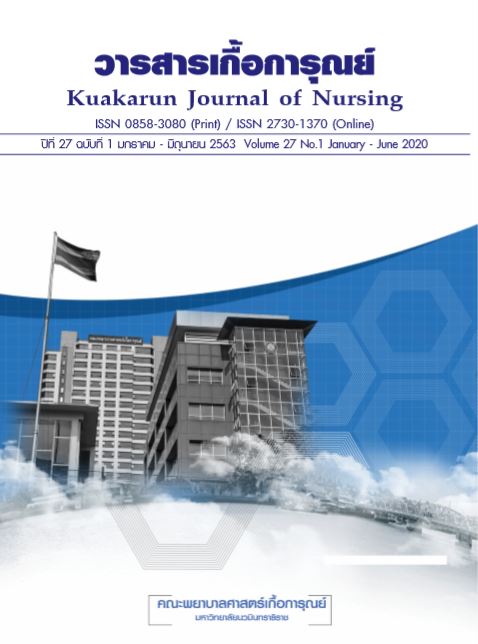การถอดบทเรียนจากการจัดการเรียนรู้โดยใช้ผู้ป่วยจำลองในสถานการณ์เสมือนจริง: วิชาการพยาบาลครอบครัวและชุมชน 1
คำสำคัญ:
การเรียนรู้โดยใช้สถานการณ์เสมือนจริง, ผู้ป่วยจำลอง, การพยาบาลครอบครัวและชุมชน 1บทคัดย่อ
การจัดการเรียนรู้โดยใช้ผู้ป่วยจำลองในสถานการณ์เสมือนจริง เป็นการส่งเสริมให้ผู้เรียนมีความรู้ มีทักษะการปฏิบัติการพยาบาล การคิดวิเคราะห์ การตัดสินใจทางการพยาบาล และทักษะที่ไม่ใช่การปฏิบัติการพยาบาล เช่น การทำงานเป็นทีม และการสื่อสาร ในการจัดการเรียนการสอนรายวิชาการพยาบาลครอบครัวและชุมชน 1 หัวข้อกระบวนการพยาบาลครอบครัว ได้นำแนวคิดของเจฟฟรีย์ ประกอบด้วย 3 ขั้นตอน คือ 1) ขั้นเตรียมความพร้อม 2) ขั้นการปฏิบัติสถานการณ์ 3) ขั้นสรุปการปฏิบัติ ได้มีการออกแบบสถานการณ์ให้เสมือนจริงทั้งในด้านสิ่งแวดล้อมและบริบทของการให้บริการแก่ครอบครัวที่บ้าน โดยผู้เรียนมีปฏิสัมพันธ์กับผู้ป่วยจำลอง มีการฝึกทักษะการใช้กระบวนการพยาบาลครอบครัว ได้แก่ การประเมินสภาวะครอบครัว การวินิจฉัยปัญหาของครอบครัว การวางแผนการพยาบาลครอบครัว การปฏิบัติตามแผน และการประเมินผลการพยาบาลครอบครัว จากการถอดบทเรียนการเรียนรู้ในครั้งนี้ พบว่าผู้เรียนได้รับความรู้ทางการพยาบาลครอบครัวและฝึกทักษะการใช้กระบวนการพยาบาลครอบครัว ทักษะการสื่อสารและการทำงานเป็นทีมทำ ให้เกิดความมั่นใจในการเรียนรู้สามารถให้การพยาบาลครอบครัวได้อย่างเหมาะสม ผู้เรียนเกิดทัศนคติที่ดีต่อการเรียน ได้เรียนรู้ข้อผิดพลาดของตนและผู้อื่นในการนำมาปรับใช้ในการเรียนรู้ในการพัฒนาการพยาบาลอนามัยชุมชนให้ดีขึ้นต่อไป
เอกสารอ้างอิง
Punthasee P, Sikaow O. The effect of clinical teaching by using case studies on the ability development of applying nursing process in clinical practice of nursing students. Thai Journal of Nursing Council 2009;24(3):81-93. (in Thai)
Norkaeo D. Simulation based learning for nursing education. Journal of Boromarajonani College of Nursing, Bangkok 2015;31(3):112-22. (in Thai)
Levine AI, Swartz MH. Standardized patients: the “other” simulation. Journal of Critical Care 2008;23(2):179-84.
Robinson-Smith G, Bradley PK, Meakim C. Evaluating the use of standardized patients in undergraduate psychiatric nursing experiences. Clinical Simulation in Nursing 2009;5(6):e203-e11.
Sinthuchai S, Ubolwan K, Boonsin S. Effects of high-fidelity simulation based learning on knowledge, satisfaction, and self-confidence among the fourth year nursing students in comprehensive nursing care practicum. Ramathibodi Nursing Journal 2017;23(1):113-27. (in Thai)
Soivong P, Suksatit B, Khampolsiri T, Suwankruhasn N. The use of standardized patients in nursing education. Ramathibodi Nursing Journal 2015;21(3):289-97. (in Thai)
Norose T. Development of integrated clinical abilities by simulated patient assisted problem-based learning tutorial. Journal of the Pharmaceutical Society of Japan 2013;133(2):223-30.
Churchouse C, McCafferty C. Standardized patients versus simulated patients: is there a Difference?. Clinical Simulation in Nursing 2012;8(8):e363-e5.
Jeffries PR. A framework for designing, implementing, and evaluating simulations used as teaching strategies in nursing. Nursing Education Perspectives 2005;26(2):96-103.
Steinwachs B. How to facilitate a debriefing. Simulation & Gaming 1992;23(2):186-95.
Jaye P, Thomas L, Reedy G. 'The Diamond': a structure for simulation debrief. The clinical teacher 2015;12(3):171-5.















